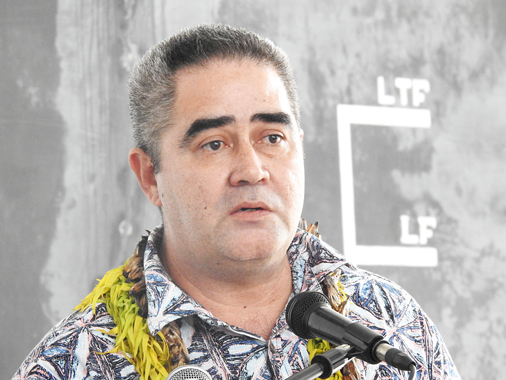By Mataeliga Pio Sioa
Swimming everyday is normal for the children of Manono growing up on a small island surrounded by the sea.
The General Manager of the Samoa Shipping Corporation, Leiataua Mr. Samuel Phineas, knows all about it.
Manono is his home island where he grew up and is as comfortable at sea as on dry land.
The natives of the island are famous for their seafaring prowess.
The popular ‘fautasi’ longboat race to celebrate independence is where the natural seafaring skills of the Manono men and women are on full display as regular winners.
This was the environment that forged a lifetime career for Leiataua who used to steal boat rides around the island when he is not swimming in the waters.
His career took him away from Samoa on ocean trips firstly around the region and into distant international sea routes far from his little home island.
How he finally ended up working on the seas came out last Friday in a personal account of his life and challenges as a seafarer to celebrate the International Seafarers Day.
Leiataua was one of the key speakers at the Maritime Ocean Campus of the NUS at Mulinu’u where the event was held.
“ It never crossed by mind that I will become a seafarer,” he reflected on the run of events while growing up.
There was not turning back, however, when he found himself at the Marine Training Centre at Toloa.
He was molded into a seafarer at the training centre in 1996 in a period of time he remembered well when he graduated.
“Our training school graduation was scheduled on White Sunday week and on Friday I graduated.
“On Sunday I went to White Sunday church service and gave my ‘tauloto’ and then on Monday I joined the crew of the Forum Samoa [regional shipping company].”
His first sailing trip to start off his seafaring career took him to American Samoa, New Zealand, Fiji and back home to Samoa.
The years rolled along and after several decades at sea he gradually found himself back on land behind a desk.
As soon as his landlubber legs returned he became involved in molding new seafarers as a senior lecturer at the School of Maritime while he raised his young family.
Last year his land travels took him all the way to the top of the Samoa Shipping Corporation ladder as General Manager of the state owned shipping services.
What he earns now cannot be compared to more than 20 years ago when his weekly earning at the outset was $23 tala a week after tax and other pay cuts.
“We were, however, happy with the work so there was nothing wrong with it.”
What he and others in the crew at the time struggled with most was missing home by having to wait months out at sea to hear from them.
Calling home on cellphone anytime you want is normal for today’s seafarers but a luxury Leiataua and the others hardly afford and so were stuck to the affordable option of letter writing.
The only problem is the nature of their work traveling from one port to another.
“ Back in the day it’ll take up to 3 months before you finally get your mail and by then you’d have up to 40 letters to read.”
Looking back at his seafaring time, Leiataua, is able to smile and be happy at the many improvements that are happening now in the working conditions.
Living quarters for men and women seafarers are a vast difference now than during his time.
Much of the credit goes to the many conventions to improve working environment in terms of safety and benefits.
After quiet observations over the last few years the SSC General Manager wants to see the young seafarers push their way all the way to officers rank in the chain of command.
‘This is the challenge for our Seafarers Association to find ways to push our young members to aim and go higher.
‘Many of our senior members are close to retirement age so we need a new wave of young members to move in and take over.”
Leiataua believed from his own experience that hard and honest work is the proven formula for success.
Going the extra mile will reap rewards in the long run.
Seafaring has become a family career for Leiataua who followed after his father Leiataua Herbert Phineas.
His father retired to work with the Union Steam Ship after his time serving on board the legendary cargo ships Tofua and Matua that sailed the island routes including Samoa.
“During that time I would hang around the wharf riding forklifts or sneaking off on the tug boat.”
Whether any of his 4 boys or 3 girls will follow his career footprints like he did his father remains to be seen.
Perhaps the most persuasive influence Leiataua has is being a model of inspiration for future seafarers.
He was come a long way from the young Manono boy will swim all day and steal boat rides around his home island.
Many of the young bright, bushy-eyed, seafarers will want that too.
